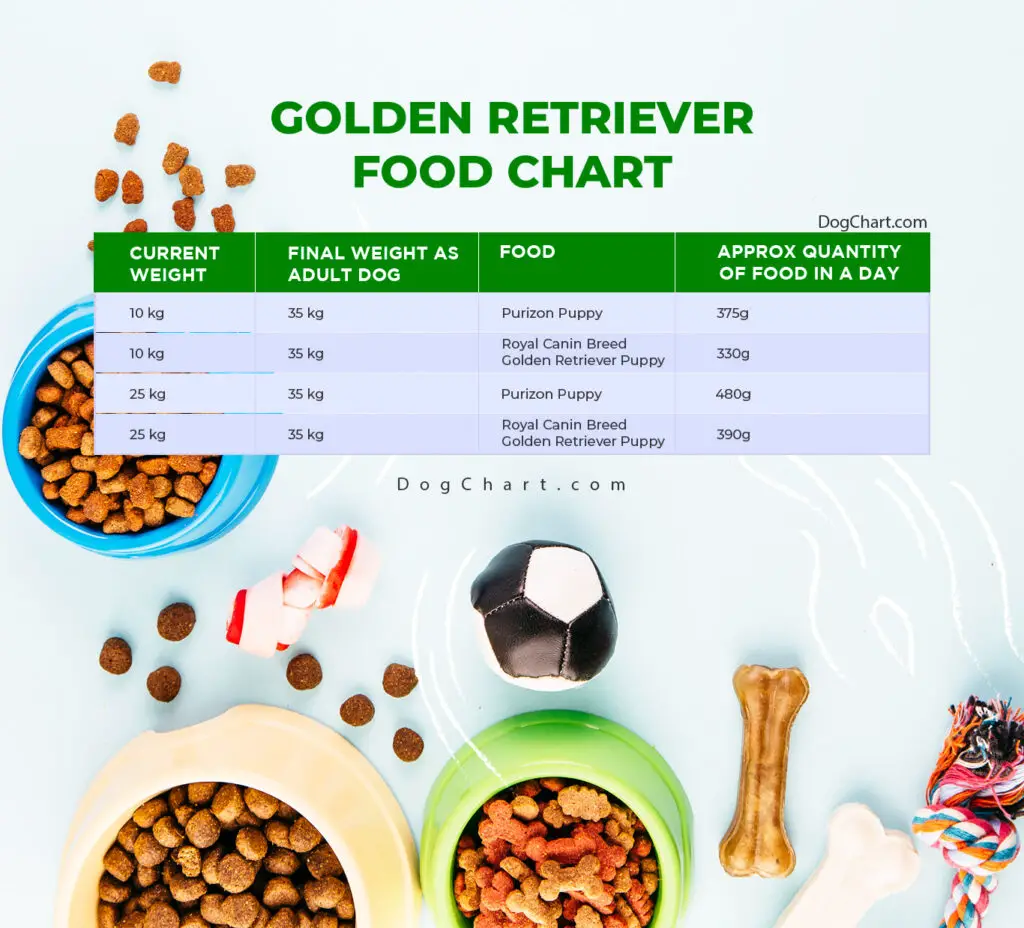You’ve undoubtedly observed that your goldie always seems to be starving, even after you’ve filled their dish. Your golden retriever is a big, active dog with a big appetite to match. However, a golden retriever food chart may ensure that your pet isn’t overfed, which is never good for their health.
Feeding your golden retriever the right amount of food might be difficult, but it’s essential for their health and well-being. An improper golden retriever diet will only increase Goldens’ predisposition for obesity and joint issues.
Feeding a golden retriever puppy is not the same as feeding an older dog, so consider your dog’s age, activity level, weight, and health status when developing a feeding schedule.
Whether you have a new puppy, an adult dog, or an older dog, you’ll find helpful information on feeding your golden retriever right here. In light of this, if you kindly remain with me, I will assist you in developing an appropriate food plan and meal schedule for your goldie.

Diet Chart for Golden Retriever Puppy Feeding Chart (2 to 12 months)
In the first four weeks of life, a Golden Retriever puppy may get all the nutrients it needs from its mother’s milk. If no mother’s milk is available, a puppy milk substitute may be given.
When a Golden puppy reaches one month, it is time to switch from breast milk to dry puppy food. Feed your puppy a high-quality weaning meal designed to suit its nutritional demands.
Puppies of all breeds, especially Golden Retrievers, need a higher-calorie diet to reach their full size and potential.
| Current Weight | Final Weight as Adult Dog | Food | Approx Quantity of Food in A Day |
|---|---|---|---|
| 10 kg | 35 kg | Purizon Puppy | 375g |
| 10 kg | 35 kg | Royal Canin Breed Golden Retriever Puppy | 330g |
| 25 kg | 35 kg | Purizon Puppy | 480g |
| 25 kg | 35 kg | Royal Canin Breed Golden Retriever Puppy | 390g |
Adult Golden Retriever Feeding Chart (1 to 7 years)
The golden retriever matures between the ages of 12 and 24 months. Many variables influence the final size of a mature Golden Retriever, including but not limited to the dog’s gender, genetic variants, breed type, health status, and degree of exercise.
When infants reach the age of 12 to 14 months, their calorie requirements typically drop. Their vitamin and mineral needs shift as they develop. Omega 3 fatty acids, protein, and fat are essential for their development.
A protein-rich food will aid in your dog’s efforts to gain lean muscle. Dogs require the correct amount of fats for energy, and unsaturated fats are particularly beneficial to their skin health due to their role in maintaining overall health, according to the Golden Retriever Food Chart.
The protein content improves stamina and bone density in adult Golden Retrievers, defined as dogs aged 15 months or older. They require lipids at this age to restore the lustre of their coats. Likewise, fats may help slow down your hair’s shedding process.
To increase your dog’s energy levels, you should increase the number of carbohydrates in his food. Adding omega fatty acids to your Golden Retriever food is crucial for improving his general mobility.
Also read: Golden Retriever Growth Stages
Senior Golden Retriever Feeding Chart (8 years and above)
Around the time a Golden Retriever reaches the ripe old age of eight, its activity level naturally declines. Because of their increased susceptibility to obesity in old age, caring for an elderly dog is more complicated than caring for a younger one.
Selecting an appropriate food chart for golden retrievers is advised.
This will help it maintain a healthy weight and prevent excess stress on its joints. Adjust your senior Golden Retriever’s food as recommended by your vet.

May I tell you a wonderful truth about your dog? … You have been given stewardship of what you in your faith might call a holy soul.
Dean Koontz
Additional Methods of Nutritional Supplementation
There are additional alternatives for golden retriever dog food beyond the kibble I focused on in this post. However, they don’t always meet dietary needs, might be expensive, or take too much time to prepare.
Wet Food
Canned food may be fed alone or in combination with kibble. However, just the cost of wet foods is prohibitive.
Eventually, you’ll want to switch your puppy to kibble, but it may not be as appealing to him as the canned food he’s been eating. He may develop a limited diet.
Wet food would have to be given in large quantities to ensure he gets all the nutrients. The high water content of his diet will also increase the frequency with which he has to use the restroom.
Eating a Raw or BARF
Bones and raw food, or BARF, is the acronym for “biologically suitable raw food.” Raw feeding has been the subject of debate.
Some veterinarians claim it doesn’t provide enough nutrition and that the germs in raw bones and meat may harm both dogs and their owners.
Dogs may choke on the bones, chip their teeth on them, or even have their intestines punctured by them. Some dangers are mitigated while eating dehydrated raw foods. But doctors agree that a raw food diet is not suitable for pups.
The puppy’s growth depends on the correct ratio of calcium to phosphorus. This ratio is notoriously challenging to achieve on a raw food diet.
Also read: Golden Retriever Coat Colors
Homemade Food for Golden Retriever Puppy
The thought of preparing a meal for a close friend is enticing. Indeed, a sizable population may be found to fall under this category. You have complete knowledge of the substances and the standard to which they are held.
But there are downsides to this as well. It’s difficult to tell whether your meals include all the necessary nutrients.
A veterinary nutritionist-developed or -approved recipe may be used, of course. In addition, you may enhance your dog’s food with ingredients recommended by veterinarians.
Another negative aspect is the time required to formulate a diet for a large-breed puppy.
I’ve always given my dogs commercial food that’s complete and balanced. And it’s helped them maintain good health. Naturally, I’ve done a ton of reading on the golden retriever food guide.
FAQs
What is the best dog food for golden retrievers?
There are a few things to remember when choosing the best dog food for Golden Retrievers. First, make sure that the food is made with high-quality ingredients. Second, choose a food that is designed for active dogs. Third, ensure the food contains all the nutrients your Golden needs.
How long should a golden retriever stay on puppy food?
Small breeds can switch at 7 to 9 months; more giant breeds at 12, 13, or even 14 months. Err on the side of caution: Better to be on puppy food a little too long than not long enough. After age 1: Most owners feed adult dogs two half-portions a day.
Concluding Remarks
Please make sure the food you feed your golden puppy is formulated for large-breed pups and has a complete and balanced set of nutrients to ensure he grows strong and healthy. He’ll grow and be healthy depending on how much you feed him.
According to the Golden Retriever Food Chart, the amount of food a golden retriever puppy should get is not a set number. The figures provided are meant just as suggestions. Alter them as you see fit for your pet.